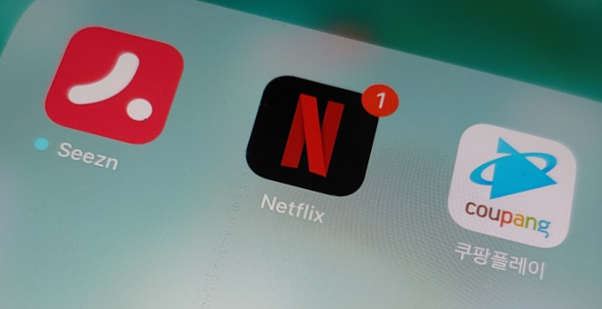As telecommuting and so-called ‘Stay-at-Home’ increased worldwide due to COVID-19, the number of OTT users also increased. According to The Export-Import Bank of Korea, the scale of worldwide OTT markets jumped 15 percent as of the last year, especially the domestic OTT market which has grown at an annual average rate of 28% since 2012. Also the Korea Communications Commission estimated that OTT market size would be about 1 trillion won. This can be seen as the opening of the so-called “OTT heyday” by many companies entering the OTT market.

In the midst of this, OTT, which has firmly maintained its No. 1 position in the number of users even before the outbreak of COVID-19, is Netflix. Netflix is a video streaming platform that first launched in the United States in 1998, and it currently dominates the global OTT market. According to Netflix’s official website, Netflix is a streaming service that can be viewed on thousands of devices which can connect to the Internet. With a monthly plan, you can watch the contents as much as you want at any time without any advertisements, and Netflix offers new series and movies are provided every week. Netflix has a total of three licenses, divided into Basic, Standard, and Premium, and each rate system shows a difference in the number of simultaneous users and image quality along with the price.
Netflix is a leader in the OTT industry, which has been in the spotlight around the world for various original contents that have been directly organized and accumulated for a long time. Unlike traditional media outlets, Netflix Original releases all episodes at once on a season-by-season basis, which contributes greatly to Netflix’s popularity and makes many people crave curiosity and waiting. It can be seen that Netflix’s Korean work, Squid Game, was so popular that few people have not seen it, and Netflix’s domestic demand and interest have increased significantly. Netflix contents have a wide variety of genres and videos to watch, and as they are riding the flow of global media, future contents are highly expected. However, in the increasingly popular OTT industry market, emerging OTT powerhouses that threaten Netflix’s position are also appearing one after another, and they are attracting consumers to use content more cheaply for the price of use. However, Netflix has its own principles and has already created subscribers with several popular content series.
Dinosaur IT companies such as Apple and Amazon are also jumping into the OTT market. It generates fixed sales every month with OTT and serves as a stepping stone to expand to various service platforms such as shopping and game information search. Among them, Apple entered the OTT market with ‘Apple TV Plus’. The subscription fee is $4.99 per month, which is the cheapest among major OTTs. Apple TV Plus plans to produce an original series and provide contents from leading cable channels such as HBO and Showtime.
Korean companies have also launched various OTT services. Watcha is an OTT that has various movies and dramas, and has feed and comment functions and tag-based recommendation functions. Watcha started off as an OTT that specializes in movies and expanded its contents to dramas, entertainment shows, and educational programs from 2015. WAVVE is an Internet-based OTT service which is a collaboration of SK Telecom and four Korean terrestrial broadcasting systems (KBS, SBS, MBC, and EBS). TVING is a CJ-affiliated OTT established in 2020, providing various categories of dedicated hall services, and has a video sharing function through SNS linkage. Recently, the contents of “TVING Original,” which are its self-produced contents, went viral. TVING has the advantage of being significantly lower in price compared to Netflix while providing services similar to Netflix.
Netflix, which actually monopolizes the OTT market, raised subscription fees by up to 17% last year. The fact that other OTT services are steadily evolving to compensate for shortcomings, and that more OTT services are expected to be released is enough to change the landscape of the OTT market. To prepare for these changes, Netflix should listen to consumers’ needs. Netflix should not raise subscription fees any more to reduce the price burden, which is the biggest complaint of consumers. Also, as the price has already been raised, it should provide more diverse and high-quality contents than before. In addition to making more efforts to produce its original contents, which are its flagship products, it will also have to provide differentiated contents, thereby responding to the rapidly changing trend of the OTT market.
Netflix responded to the ongoing increase in subscription fees by saying, “Netflix membership fees may change as we continue to add more TV shows and movies and introduce new product features. It may also change to accommodate changes in the local market, such as changes in local taxes and inflation. ” Currently, as inflation continues in the global market, it appears to be an option made to reduce the ongoing tax burden. On the other hand, there are opinions that the price of Netflix, which offers movies and dramas in various countries and fields, is reasonable due to the increase in cultural living expenses such as movies. The greatest advantage for consumers is that they can freely watch at any time and place they want. However, consumers continue to express dissatisfaction with Netflix’s increased subscription fees and restrictions on account sharing.
Is this Netflix’s best option for responding to a changing market? As the saying goes, ‘Those who want to wear the crown, bear the weight’, Netflix needs that much effort to keep its No. 1 position in OTT market share. As it occupies the first place in OTT market share, Netflix will have to find other practical ways to satisfy consumers’ tastes in order to maintain the number of subscribers at this point and continue to lead in the OTT market, which is becoming more diverse as time goes by.
K-UNIV
Asia Journal



